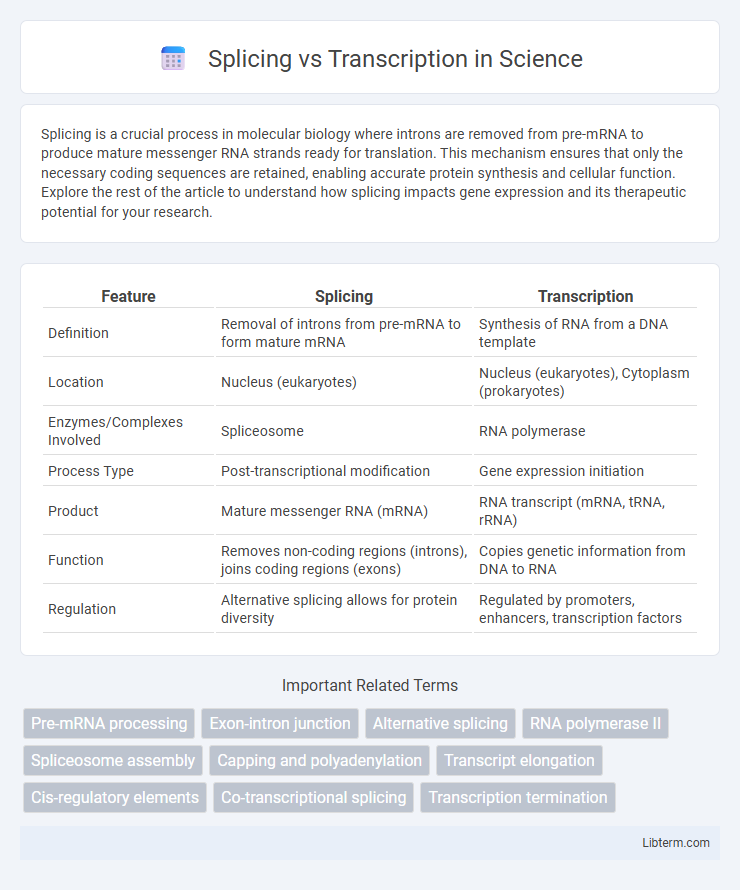Splicing is a crucial process in molecular biology where introns are removed from pre-mRNA to produce mature messenger RNA strands ready for translation. This mechanism ensures that only the necessary coding sequences are retained, enabling accurate protein synthesis and cellular function. Explore the rest of the article to understand how splicing impacts gene expression and its therapeutic potential for your research.
Table of Comparison
| Feature | Splicing | Transcription |
|---|---|---|
| Definition | Removal of introns from pre-mRNA to form mature mRNA | Synthesis of RNA from a DNA template |
| Location | Nucleus (eukaryotes) | Nucleus (eukaryotes), Cytoplasm (prokaryotes) |
| Enzymes/Complexes Involved | Spliceosome | RNA polymerase |
| Process Type | Post-transcriptional modification | Gene expression initiation |
| Product | Mature messenger RNA (mRNA) | RNA transcript (mRNA, tRNA, rRNA) |
| Function | Removes non-coding regions (introns), joins coding regions (exons) | Copies genetic information from DNA to RNA |
| Regulation | Alternative splicing allows for protein diversity | Regulated by promoters, enhancers, transcription factors |
Introduction to Gene Expression
Gene expression begins with transcription, where DNA sequences are copied into pre-mRNA by RNA polymerase. Splicing follows transcription, removing introns and joining exons to create mature mRNA that directs protein synthesis. This coordinated process ensures accurate translation of genetic information into functional proteins.
What is Transcription?
Transcription is the process in which the DNA sequence of a gene is copied into messenger RNA (mRNA) by the enzyme RNA polymerase. This foundational step in gene expression occurs in the cell nucleus, producing a complementary RNA strand from the DNA template. Transcription enables the transfer of genetic information from DNA to RNA, which is essential for subsequent protein synthesis.
The Mechanism of Transcription
Transcription involves RNA polymerase binding to the DNA promoter region, initiating the synthesis of pre-mRNA by reading the template strand in a 5' to 3' direction. The process includes three stages: initiation, elongation, and termination, where RNA polymerase unwinds DNA, synthesizes RNA, and releases the transcript after reaching the terminator sequence. Unlike splicing, which modifies pre-mRNA post-transcription by removing introns, transcription generates the primary RNA transcript essential for gene expression.
Understanding RNA Splicing
RNA splicing is a crucial step in gene expression where non-coding introns are removed from pre-messenger RNA (pre-mRNA) to produce mature mRNA molecules ready for translation. This process is facilitated by the spliceosome, a complex of small nuclear RNAs (snRNAs) and proteins that recognize specific splice sites at exon-intron boundaries. Unlike transcription, which synthesizes the initial RNA strand from DNA, RNA splicing refines this transcript to ensure the correct sequence encoding functional proteins.
How Splicing Differs from Transcription
Splicing differs from transcription in that splicing is a post-transcriptional process where introns are removed and exons are joined to form mature mRNA, whereas transcription involves synthesizing RNA from a DNA template. Unlike transcription, which creates a precursor RNA strand, splicing modifies this precursor RNA to produce a functional and translatable mRNA molecule. Splicing occurs in the nucleus and is facilitated by the spliceosome, emphasizing its role in RNA processing rather than RNA synthesis.
Key Enzymes in Transcription and Splicing
RNA polymerase is the key enzyme in transcription, responsible for synthesizing messenger RNA (mRNA) from the DNA template. In splicing, the spliceosome complex, which includes small nuclear ribonucleoproteins (snRNPs) such as U1, U2, U4, U5, and U6, catalyzes the removal of introns from pre-mRNA. Both processes are essential for gene expression regulation, with transcription initiating RNA synthesis and splicing ensuring mRNA maturation and proper coding sequence formation.
Biological Significance of Splicing and Transcription
Transcription is the essential process by which DNA is copied into messenger RNA (mRNA), enabling gene expression and protein synthesis necessary for cellular function. Splicing refines this mRNA by removing non-coding introns and joining exons, increasing transcript diversity and enabling a single gene to produce multiple protein variants. Both transcription and splicing are critical for regulating gene expression, maintaining cellular complexity, and responding to developmental and environmental signals.
Regulation of Transcription vs Splicing
Regulation of transcription controls gene expression by modulating RNA polymerase activity, promoter accessibility, and transcription factor binding, impacting the quantity of pre-mRNA produced. In contrast, splicing regulation influences the diversity of mRNA isoforms through spliceosome assembly and selection of splice sites, affecting post-transcriptional modification. Both processes are tightly coordinated, with transcription factors and RNA-binding proteins playing critical roles in determining gene expression dynamics and alternative splicing outcomes.
Common Errors in Splicing and Transcription
Common errors in splicing include exon skipping, intron retention, and cryptic splice site selection, which can lead to the production of aberrant mRNA and dysfunctional proteins. Transcription errors frequently involve RNA polymerase slippage or misincorporation of nucleotides, resulting in mutations or truncated transcripts. Both splicing and transcription errors contribute to genetic diseases and cellular dysfunction by disrupting normal gene expression and protein synthesis.
Applications in Medicine and Biotechnology
Splicing enables the production of diverse protein isoforms from a single gene, critical for developing targeted therapies and precision medicine, while transcription regulates gene expression patterns essential for diagnosing genetic disorders. In biotechnology, manipulating splicing factors or transcriptional regulators allows custom design of gene expression systems for protein production and gene therapy. Advances in CRISPR and RNA sequencing technologies leverage both splicing and transcription understanding to innovate treatments for diseases like cancer and genetic disorders.
Splicing Infographic

 libterm.com
libterm.com